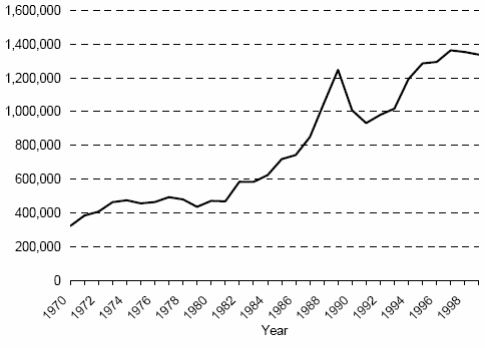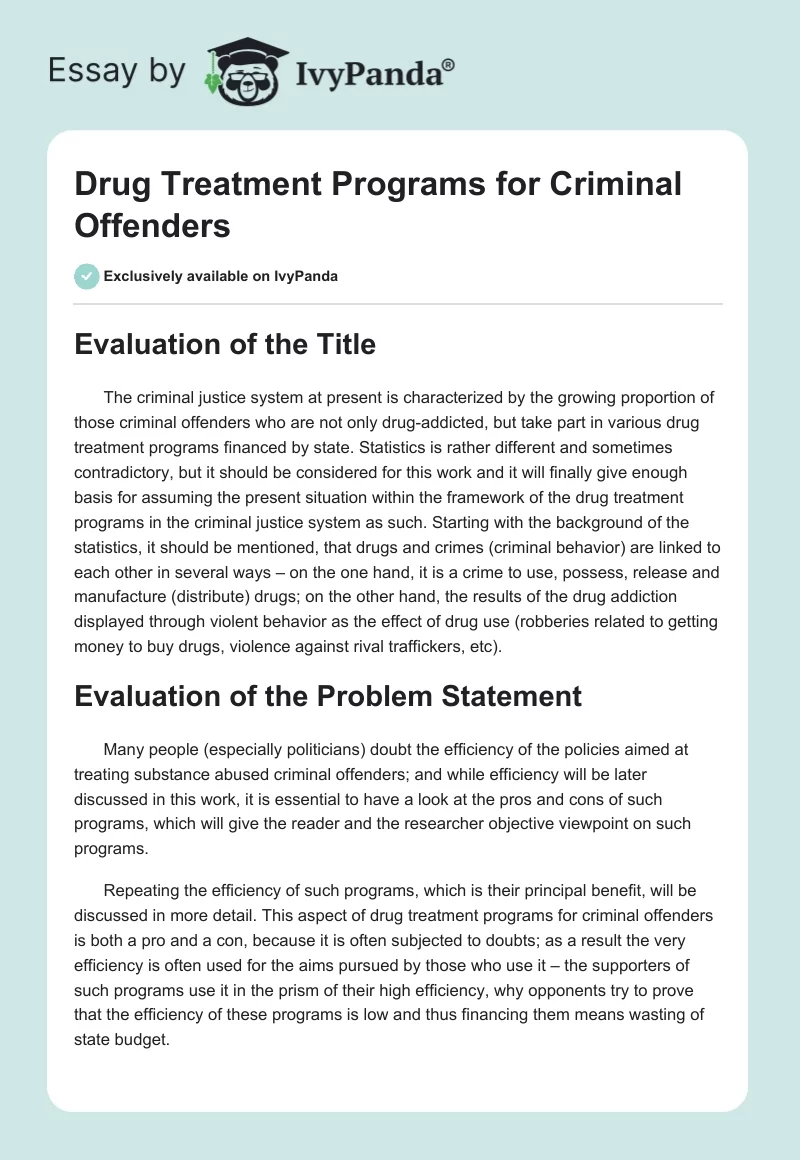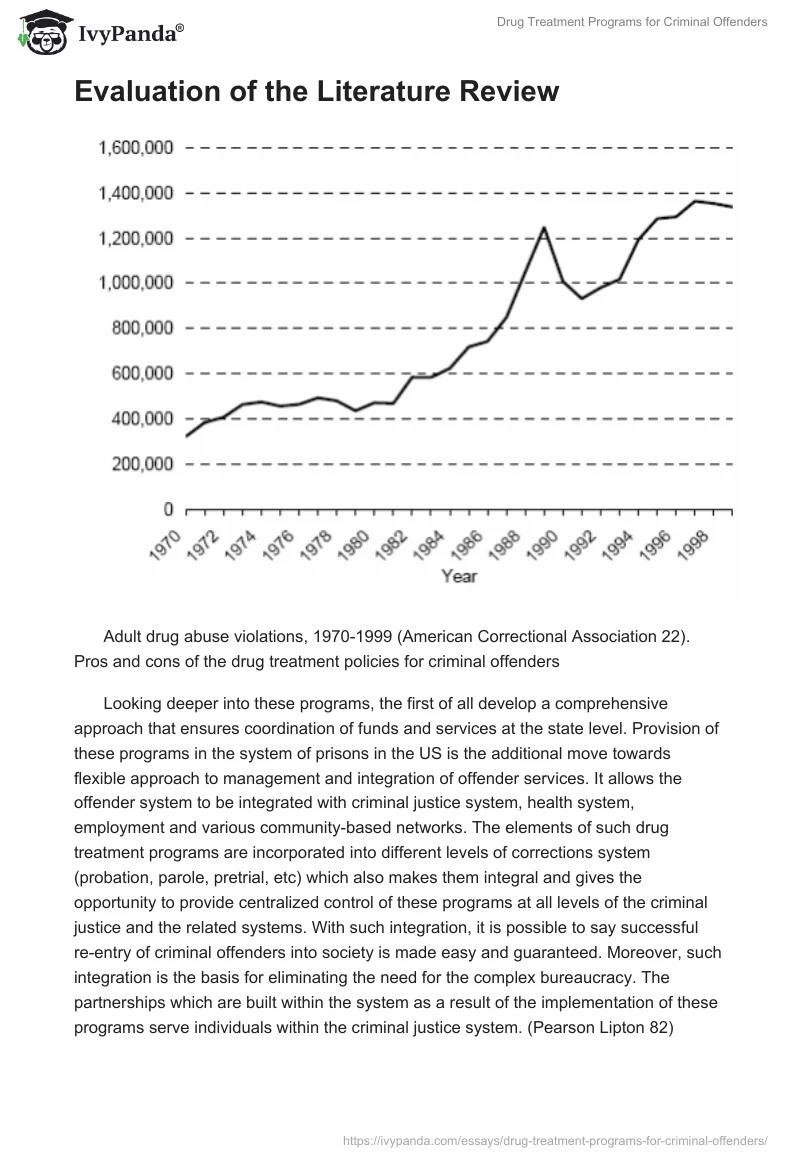Evaluation of the Title
The criminal justice system at present is characterized by the growing proportion of those criminal offenders who are not only drug-addicted, but take part in various drug treatment programs financed by state. Statistics is rather different and sometimes contradictory, but it should be considered for this work and it will finally give enough basis for assuming the present situation within the framework of the drug treatment programs in the criminal justice system as such. Starting with the background of the statistics, it should be mentioned, that drugs and crimes (criminal behavior) are linked to each other in several ways – on the one hand, it is a crime to use, possess, release and manufacture (distribute) drugs; on the other hand, the results of the drug addiction displayed through violent behavior as the effect of drug use (robberies related to getting money to buy drugs, violence against rival traffickers, etc).
Evaluation of the Problem Statement
Many people (especially politicians) doubt the efficiency of the policies aimed at treating substance abused criminal offenders; and while efficiency will be later discussed in this work, it is essential to have a look at the pros and cons of such programs, which will give the reader and the researcher objective viewpoint on such programs.
Repeating the efficiency of such programs, which is their principal benefit, will be discussed in more detail. This aspect of drug treatment programs for criminal offenders is both a pro and a con, because it is often subjected to doubts; as a result the very efficiency is often used for the aims pursued by those who use it – the supporters of such programs use it in the prism of their high efficiency, why opponents try to prove that the efficiency of these programs is low and thus financing them means wasting of state budget.
Evaluation of the Literature Review

Looking deeper into these programs, the first of all develop a comprehensive approach that ensures coordination of funds and services at the state level. Provision of these programs in the system of prisons in the US is the additional move towards flexible approach to management and integration of offender services. It allows the offender system to be integrated with criminal justice system, health system, employment and various community-based networks. The elements of such drug treatment programs are incorporated into different levels of corrections system (probation, parole, pretrial, etc) which also makes them integral and gives the opportunity to provide centralized control of these programs at all levels of the criminal justice and the related systems. With such integration, it is possible to say successful re-entry of criminal offenders into society is made easy and guaranteed. Moreover, such integration is the basis for eliminating the need for the complex bureaucracy. The partnerships which are built within the system as a result of the implementation of these programs serve individuals within the criminal justice system. (Pearson Lipton 82)
Evaluation of the Purpose, Hypotheses, and Research Questions
Due to the relapsing nature of drug addiction, there should also be ‘an appreciation of recovery as a long-term process that may require multiple treatment episodes’. (Vigdal & Stadler 44) One of the benefits of drug treatment programs is the fact that they encourage reentering persons to access appropriate opportunities for post-incarceration services. These programs provide opportunities for states and localities to develop clinical responses across a variety of systems to provide incentives for more effective offender-release procedures. These programs also encourage the application of the best practices from corrections and parole to substance abuse treatment and clinical case management. They create the basis for the integration of systems of housing, employment, substance abuse, mental health and child welfare into the offender reentry management. The benefit of the drug treatment programs for criminal offenders is that they are not limited by treating drug problems, but they exercise complex approaches to the problems of drug offenders; it appears that very often drug treatment problems also serve for the resolution of other related issues and thus provide criminal offenders with the opportunity to become full members of society. Any drug treatment program allows each of these systems to serve their primary functions while building their services, furthering the goals of community safety, offender reentry and client rehabilitation. It also encourages these sectors to understand the need for offender accountability to the court and to the community while maintaining focus on the clinical needs of the individual.
The mantra of the drug treatment community is that “treatment works.” At least in the United States, that mantra is chanted in necessary defense of beleaguered programs that do not receive the public support, funding, or policy attention that they deserve. Yet the treatment enterprise is inherently frail. For most patients, treatment is a difficult process that includes significant disappointment. It does not fully, or immediately, or comprehensively “work” in the way patients, clinicians, or the society hope that it would. These frailties can distract from the great individual and social benefits treatment provides (Pearson & Lipton 52)
Prioritization of the use of scarce criminal justice resources for the provision of drug treatment access to those who are the most vulnerable to relapse is also a significant benefit of such programs; no matter how politicians may try to resist the need and efficiency of such programs and try to prove that such programs do not bring the desired result, it is still clear that drug treatment programs for criminal offenders serve as catalysts for the development of more effective strategies of delivering services to people who are involved into the criminal justice system, and their families. This delivery and these programs are the means of increasing the living standards of those who want and try to re-enter society after incarceration or sentence. Though many programs aimed at treating drug addictions of criminal offenders serve for the education of communities about those who participate in these programs and their right to be full citizens of the given society, local and state executive agencies in many instances are responsible for funding and controlling (managing) such programs, as well as the distribution of their resources and treatment itself, it results in the complex of political and cultural barriers which create certain climate in many communities; this climate is the obstacle which makes it difficult to achieve adequate level of client services for the offenders who reenter the society. Inadequate and inconsistent programs, however, can be improved through the use of case management, funded programs and such approaches will also ensure that everyone who needs such treatment will receive it fully and according to the specific needs of each criminal offender. (Miller & Flaherty 20)
Evaluation of Data Collection
Case management is used in majority of such programs; its role is to provide coordinated assessments of individual needs, service delivery at the appropriate level and resources that are aimed at following the criminal offenders who are released from jails or prisons to their social communities, making their re-entry easier. These programs assure criminal offenders that they will acquire the necessary resources and guidance which will help them to become productive members of their society.
Due to the relapsing nature of drug addiction, there should also be ‘an appreciation of recovery as a long-term process that may require multiple treatment episodes’. (Vigdal & Stadler 34) One of the benefits of drug treatment programs is the fact that they encourage reentering persons to access appropriate opportunities for post-incarceration services. These programs provide opportunities for states and localities to develop clinical responses across a variety of systems to provide incentives for more effective offender-release procedures. These programs also encourage application of the best practices from corrections and parole to substance abuse treatment and clinical case management. They create the basis for the integration of systems of housing, employment, substance abuse, mental health and child welfare into the offender reentry management. The benefit of the drug treatment programs for criminal offenders is that they are not limited by treating drug problems, but they exercise complex approaches to the problems of drug offenders; it appears that very often drug treatment problems also serve for the resolution of other related issues and thus provide criminal offenders with the opportunity to become full members of society. Any drug treatment program allows each of these systems to serve their primary functions while building their services, furthering the goals of community safety, offender reentry and client rehabilitation. It also encourages these sectors to understand the need for offender accountability to the court and to the community while maintaining focus on the clinical needs of the individual.
The mantra of the drug treatment community is that “treatment works.” At least in the United States, that mantra is chanted in necessary defense of beleaguered programs that do not receive the public support, funding, or policy attention that they deserve. Yet the treatment enterprise is inherently frail. For most patients, treatment is a difficult process that includes significant disappointment. It does not fully, or immediately, or comprehensively “work” in the way patients, clinicians, or society hope that it would. These frailties can distract from the great individual and social benefits treatment provides (Pearson & Lipton 33)
Prioritization of the use of scarce criminal justice resources for the provision of drug treatment access to those who are the most vulnerable to relapse is also a significant benefit of such programs; no matter how politicians may try to resist the need and efficiency of such programs and try to prove that such programs do not bring the desired result, it is still clear that drug treatment programs for criminal offenders serve as catalysts for the development of more effective strategies of delivering services to people who are involved into the criminal justice system, and their families. For this study, surveys and data will be gathered from previous studies and analyzed in order to present the concepts of what is successfully working in drug treatment.
Evaluation of Data Analysis and Results
Drug treatment programs for criminal offenders manage not only substance abuse, but also mental health of criminal offenders, their medical, employment and family needs. Any drug treatment program presupposes medical case management, as well as clinical reentry case management; these two aspects of such programs will most likely result in the following benefits of the drug treatment programs:
- depending on the kind of program, it is possible that such program screens and assesses the housing needs of the criminal offenders; of course, many will object to the mere existence of such programs, and many will doubt that such programs exist, but if one takes TASC program aimed at drug treatment of criminal offenders, it will become understandable that such programs exist and give criminal offenders wide range of services, starting with drug treatment and ending with ensuring that released offenders would not become homeless. It is a special approach and not all programs include such approach in their agenda, but long-term residential housing and its planning should be included similar to the TASC programs. (Miller & Flaherty 84)- Drug treatment programs in their essence are much broader than they may seem at first glance. Many of them evaluate complex problems and diagnoses related to substance abuse and mental health disorders, which are very common among drug offenders; this is also one of the important pros for the support and promotion of such programs. As a result of such evaluation, the clients and their families are advised appropriate treatment and try to guarantee that the solution of these health problems for the criminal offender will keep him from recidivating. Actually, the issue of recidivism and drug treatment programs has been deeply researched, and the opinions have been divided into two opposite sides – one of them asserts that drug treatment programs are a successful tool for eliminating recidivism, connecting this factor with the statistics, according to which many crimes are committed under the influence of drugs or for finding money to buy drugs, drug treatment serves as the basis for eliminating the causes and the need for crime as it is; on the other hand the opinions have shown that treatment cannot reduce recidivism as the treatment itself for criminal offenders cannot be efficient, and thus is not needed, and there is no more efficient measure for criminal offenders than incarceration. It should be admitted that both opinions have reasonable grounds for them, but the researcher here still tends to the thought that these programs are necessary; they should only be amended to make them work in the real circumstances and not on the theoretical notions.
Evaluation of the Writing
The benefits and drawbacks of treatment may be characterized by having many dimensions, which affect both the individual and the community the member of which he is. Crime reduction is often the most conspicuous, and is often the dominant, benefit, when the results of drug treatment programs are analyzed through economic prism. The larger portion of the noted benefits of drug treatment for criminal offenders arises from the fewer portions of patients who have committed serious offenses before starting the treatment. ‘The social benefits of crime reduction are much smaller for the median client, and are smaller for marijuana than for other substances which are more correlated with felony offending’. (Manski, Pepper & Thomas 99) Crime reduction gives important benefits for those who are drug addicts as well; continued offending exposes users to the risk of incarceration and criminal victimization, as well as lost short-term and long-term opportunities for legitimate employment.
Conclusion
There is a variety of scientific approaches to treating drug addictions in criminal offenders – it is necessary to describe them here in short as they will provide the basis for further discussion and will give insight into the benefits of such treatment courses for criminal offenders.
These programs use a long-acting synthetic opiate medication, usually, methadone or LAAM, administered orally for a sustained period at a dosage sufficient to prevent opiate withdrawal, block the effects of illicit opiate use, and decrease opiate craving. Patients stabilized on adequate, sustained dosages of methadone or LAAM can function normally. They can hold jobs, avoid the crime and violence of the street culture, and reduce their exposure to HIV by stopping or decreasing injection drug use and drug-related high-risk sexual behavior. (Murray 84)
References
American Correctional Association. Drug treatment intervention summary. Corrections Compendium 26(4): 8–23, 2001.
Anglin, Mary, Manny Prendergast, Dan Farabee. The effect of coerced drug treatment for drug-abusing offenders. Paper presented at the Office of the National Drug Control Policy’s Conference on Scholars and Policy Makers. Washington DC. March, 1988.
Boyum, Daniel. & Reuter, Pam. An analytic assessment of U.S. drug policy Washington, DC. The AEI Press, 2005.
Caplow, Theodore, and Jonathan Simon. Understanding prison policy and population trends. In Prisons, edited by Michael Tonry and Joan Petersilia (63–120). Chicago: University of Chicago Press, 1999.
Chaiken, Manuel. Crime rates and substance abuse among types of offenders. In: B.D.
Johnson and E.D. Wish (eds.), Crime Rates Among Drug-Abusing Offenders: Final Report to the National Institute of Justice. NY: Narcotic and Drug Research, Inc, 1986.
Criminal Justice Committee of Therapeutic Communities of America. Therapeutic communities in correctional settings: The prison based TC standards development project, Final Report of Phase II. Washington, D.C.: Office of National Drug Control Policy. 1999.
Flynn, Pamela Porto, James, Rounds, Bryant., & Kristiansen, Pamela. Costs and benefits of Methadone treatment in DATOS – part 1: Discharged versus continuing patients. Journal of Maintenance in the Addictions, 2, 129-149, 2003.
Gerstein, Danny., Johnson, Ronald, Harwood, Harry., Fountain, Donald., Suter, Nancy., & Malloy, Kelly. Evaluating recovery services: The California drug and alcohol treatment assessment (CALDATA). Sacramento, CA: California Department of Alcohol and Drug Programs, 2004.
Lightfoot, Land., & Hodgins, Donaled. A survey of alcohol and drug problems in incarcerated offenders. The International Journal of the Addictions, 23(7), 687-706.
Lipton, David S. (1996). The Effectiveness of treatment for drug abusers under criminal justice supervision: presentation at the 1995 conference on criminal justice research and evaluation. Washington, D.C.: U.S. Department of Justice, National Institute of Justice, 1988.
Manski, Camela., Pepper, James. & Thomas, Yolands. (eds.) Assessment of two cost-effectiveness studies on cocaine control policy. Washington, DC, National Academy Press, 1999.
McLellan, Atlas. Have we evaluated addiction treatment correctly? Implications from a chronic disease perspective. Addiction 97: 249-253, 2002.
Miller, Nancy., James Flaherty. Effectiveness of coerced addiction treatment (alternative consequences): A review of the clinical research. Journal of Substance Abuse Treatment. 18, 9-16, 2000.
Murray, Daniel. Drug abuse treatment programs in the Federal Bureau of Prisons: initiatives for the 90’s. In C.G. Leukefeld and F. M. Tims (eds.), Drug Abuse Treatment in Prisons and Jails (pp. 62–83). Washington, DC: U.S. GPO, 1992.
Nochajski, Todd., Miller, Bam, Wieczorek, Walter & Whitney, Ronald. The effects of a drinker-driver treatment program: Does criminal history make a difference? Criminal Justice and Behavior, 20(2), 174-189, 1993.
Pearson, Frank S., and Douglas S. Lipton. A Meta-analytic review of the effectiveness of corrections-based treatments for drug abuse. The Prison Journal 79(4): 384–410, 1999.
Peters, Roger H., and Michael Hunt. Which substance abuse screening instruments are effective for use with offenders? Suncoast Practice and Research Collaborative 1(1): 1–4, 2000.
Polcin, Donald. Drug and alcohol offenders coerced into treatment: A review of the modalities and suggestions for research on social model programs. Substance Abuse and Misuse. 36(5): 589-608, 2001.
Vigdal, Greg, and Stadler, Daniel. Comprehensive system development in corrections for drug abusing offenders: The Wisconsin Department of Corrections. In C.G. Leukefeld and 63 F.M. Tims (eds.), Drug Abuse Treatment in Prisons and Jails (pp. 126–141). Washington, DC: U.S. GPO, 1992.

